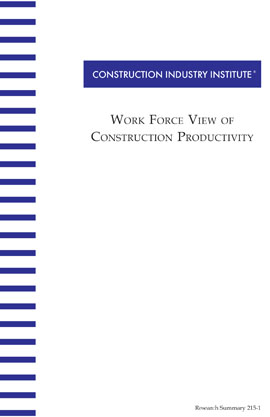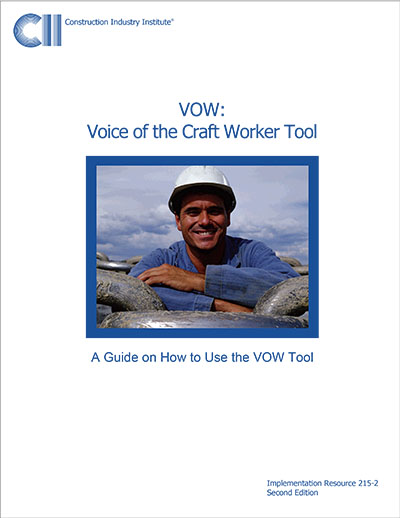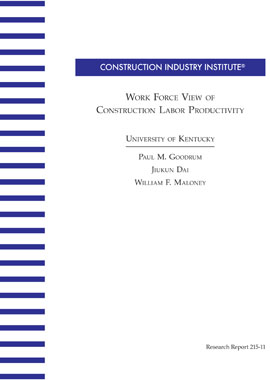
Work Force View of Construction Productivity
“I have been a fitter for 30 years, and no one has ever taken the time to administer a survey like this or asked me questions like this.”
– Craft worker, Arizona
Since the late 1980s, outsourcing and globalization have changed the face of the engineering and construction world. The chance to lower costs – particularly in design – is a major reason for going outside the U.S. for various services. Also playing a role is productivity. Historically, productivity studies have focused on the perspective of management: which best practices should be employed or which way is best in performing an activity.
Previous CII research on productivity also has taken management’s perspective. In 2004, however, CII sought a new perspective of construction productivity: that of the craft worker. It formed the Work Force View of Construction Productivity Research Team (RT 215) to collect data on processes and activities from the men and women executing them. These individuals have the best perspective of where productivity is lost and where it can be gained on a typical project, and are an excellent source of innovative solutions on how to prevent the losses and accentuate the gains. The ensuing research identified factors that have a significant impact on construction productivity. In general, tools and consumables, materials, engineering drawing management, and construction equipment were cited as primary causes for concern. Hundreds of suggestions were gathered on how to make the projects more likely to be successful. Additionally, the research team concluded that:
- Craft workers not only have a good understanding of the factors that have an impact on productivity, but also can provide an insight to root causes.
- Most of the major concerns are addressable on the jobsite.
- Productivity needs to be examined from a behavioral aspect because productivity factors involve perceptions, motivations, attitudes, and behaviors.
- Cost and progress reporting, observation, and measurement of craft perception will make a difference in a productivity assessment and management response processes.
- A greater effort is needed to engage the crafts and to establish two-way communication with them about productivity improvement.
The research team developed a comprehensive tool, the Voice of the Craft Worker (VOW), to involve craft workers in productivity improvement and assist a site management team in controlling factors that impact productivity. Successful application of the VOW tool will lead to better project planning, improved motivation of craft workers, and improved allocation of limited resources in improving productivity during construction.
This summary publication is an overview of the study and the findings of the research efforts. Readers are encouraged to read the crafts’ suggestions for improvements carefully and then see where these ideas might be put to use on their own projects.
From the categories shown in Key Finding #1, the top 10 most significant factors were:
- I have to wait for people and/or equipment to move the material I need.
- There are errors in the drawings that I use.
- When there is a question or problem with a drawing, the engineers are slow to address the issue.
- If I need a lift to do my job, there aren’t any available.
- When I need a crane or forklift to help me, there aren’t any available.
- I can’t get the consumables I need to do my job.
- I have to search in a lot of places to find the tools I need to do my job.
- When I go to install prefabricated items, work has to be done on them to fix quality problems.
- I can’t get the power tools from the contractor that I need to do my job.
- My supervisor does not provide me with enough information to do my job.
The research team concluded that:
- Craft workers not only have a good understanding of the factors that impact their productivity, but also can provide insights into the root causes.
- Most of the major concerns can be addressed on the jobsite.
- Productivity needs to be examined from a behavioral aspect because productivity factors involve perceptions, motivations, attitudes, and behaviors.
- Cost and progress reporting, observation, and measurement of craft perception can make a difference in a productivity assessment and management response processes.
- More effort is needed to engage the crafts to establish two-way communication with them about productivity improvement. (RS215-1, p. v)
The following implementation steps were developed for the VOW tool:
- As with any new field process, site management and craft workers need to be provided with an orientation that explains the purpose of the VOW tool and how it is used. The orientation should also address management’s commitment to respond to craft worker input into the tool.
- A full-scale VOW site assessment is needed to identify the significant productivity factors specific to the jobsite, typically 10 to 15 factors, that craft workers perceive as having the greatest impact on their productivity.
- Take action on craft input in order to resolve the significant productivity factors.
- Have ongoing VOW assessments by monitoring the craft worker perception of the jobsite’s productivity factors. If some productivity factors are completely resolved, the site management team may decide to drop those factors from the ongoing assessment. (RS215-1, p. 14)



